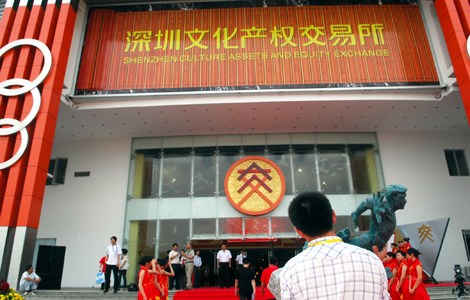
The Shenzhen Culture Assets and Equity Exchange.
Almost 10 years ago, when Chinese director Zhang Yimou borrowed $30 million from an overseas bank for his masterpiece Hero, which was nominated as Best Foreign Language Film at the Academy Awards, he became a film-financing pioneer.
At that time, government grants were the main source of money for the cultural industry in China. The domestic financial industry began to support the cultural sector in 2006, when China Merchants Bank Co Ltd provided an unsecured loan of 50 million yuan ($7.86 million) for Huayi Brothers Media Corp's film The Assembly.
Since then, the government has placed more importance on the cultural industry. The State Council approved the Blueprint for Reinvigorating the Culture Industry in September 2009, making it a national strategic development plan.
The culture boom continues to draw attention from the capital market and has led to the emergence of a new combination of culture and money.
As the first cultural assets and equity exchange on the Chinese mainland, the Shanghai Culture Assets and Equity Exchange (SHCAEE) was set up in June 2009. Its business includes the transaction of property rights, equity and intellectual property rights of cultural projects or companies.
More than 10,000 programs have been listed on the SHCAEE since its establishment, with 300 transactions to date valued at more than 15.2 billion yuan, said Zhang Tian, president of the SHCAEE.
Among the listed programs were foreign ones - such as about 1,500 programs from Japan. Most of those listings involved copyrights.
The SHCAEE has established partnerships with overseas institutions including Boston-based International Data Group, the Japan-China Economic Research Institute Ltd and Warner Brothers Entertainment Inc.
"These institutions and companies list their cultural projects on our exchange to attract investment and to seek partners, and we serve as a bridge between the two groups," Zhang said. He said that relatively affluent investors tend to show more interest in projects involving cultural infrastructure, and they're also eager to invest in the media industry, such as publishing enterprises and television stations.
Small and mid-cap investors prefer art, and most of them are former stock or real estate investors. However, art only makes up a tiny fraction of the exchange's transactions at less than 1 percent.
In terms of art trading, the Tianjin Cultural Artwork Exchange (TCAE) caught investors' eyes in the first half of 2011 by trading stakes in works of art in a manner similar to the stock market.
Shares in two paintings surged significantly after their IPOs but then plummeted because of revised trading rules, which caused huge losses for some investors.
Analysts said the lack of regulation and supervision, volatile trading rules and unclear authentication and valuation processes can easily lead to speculation.
Besides Shanghai and Tianjin, a dozen cities have established cultural exchanges in the past two years, including Shenzhen and Chengdu, and the TCAE isn't the only one to experience speculation.
The State Council recently released policy guidelines intended to reduce financial risks on cultural exchanges.
"The weak supervision system and lack of legislative regulations have contributed to market disorder, and that's why the improvement of these cultural exchanges requires government support," Zhang said, adding that there have hardly been any transaction disputes at SHCAEE over the past two years.
The industrialization of culture calls for capital, and the integration of culture and capital is a bottleneck. Trading cultural assets on equity exchanges has been a relatively good choice so far, he added.
"Although cultural assets and equity have their own characteristics, they share the same essence as other forms of property rights, which allows us to apply the regulations and rules that other property rights trades follow," said Zhu Yu, a professor of finance at the China Europe International Business School.

Copyright ©1999-2011 Chinanews.com. All rights reserved.
Reproduction in whole or in part without permission is prohibited.